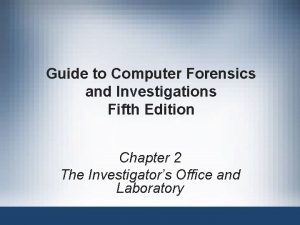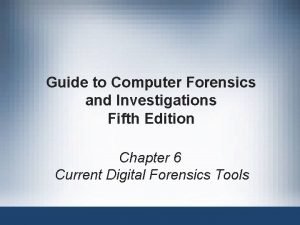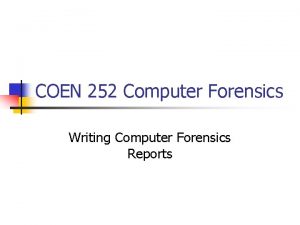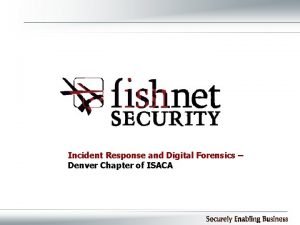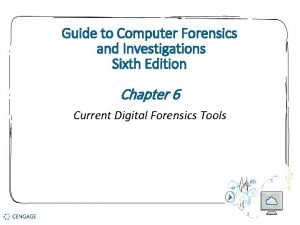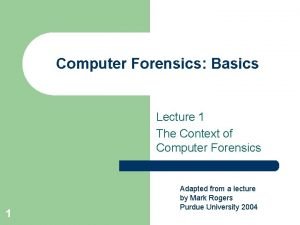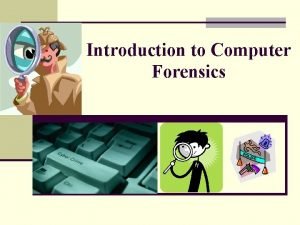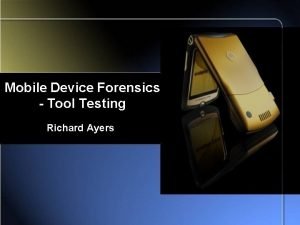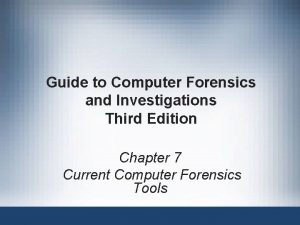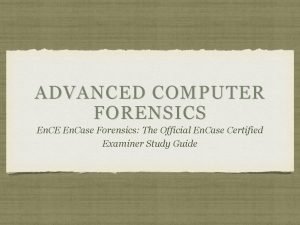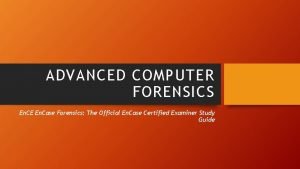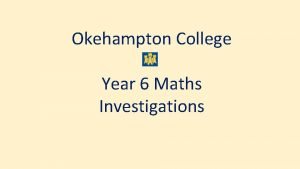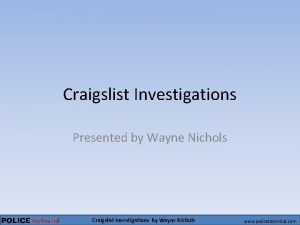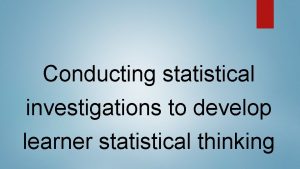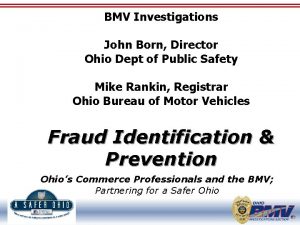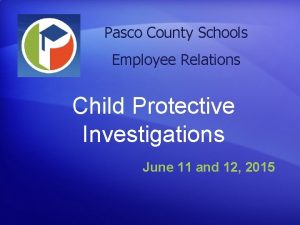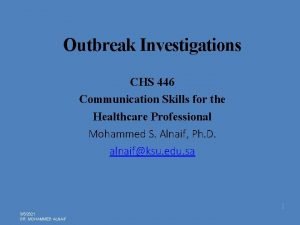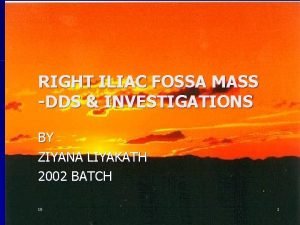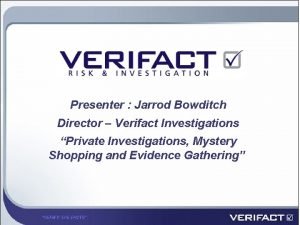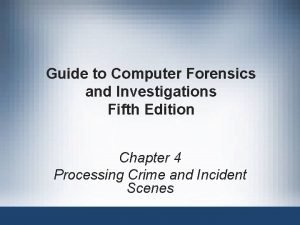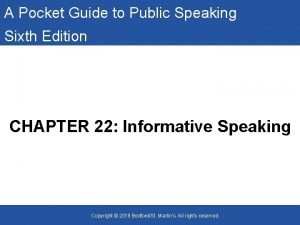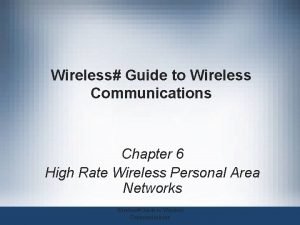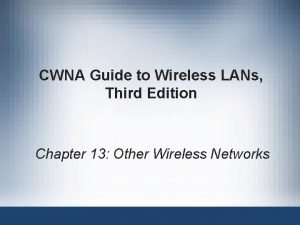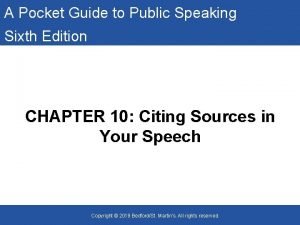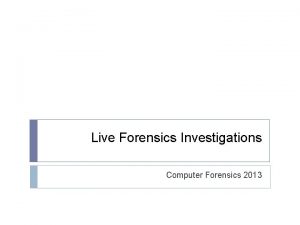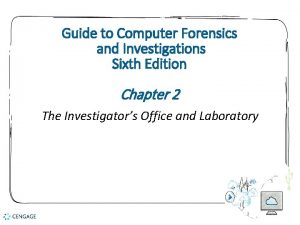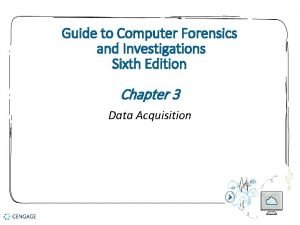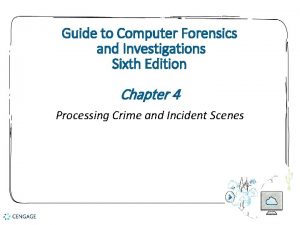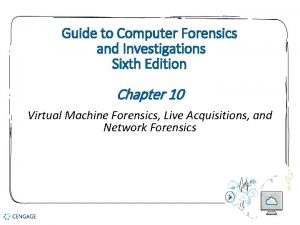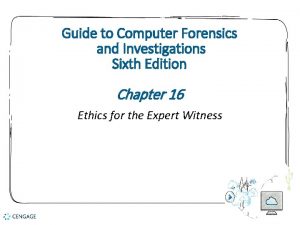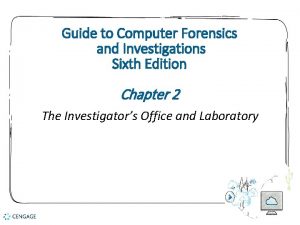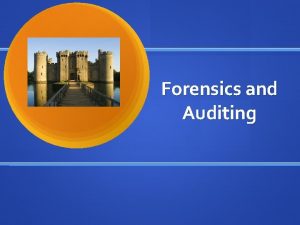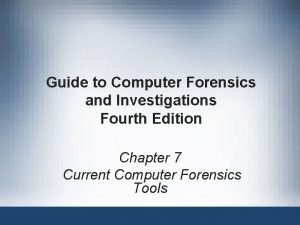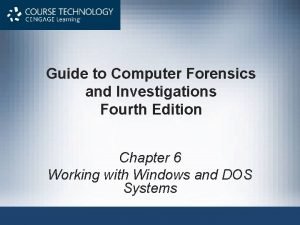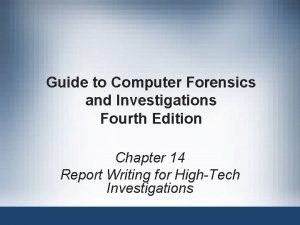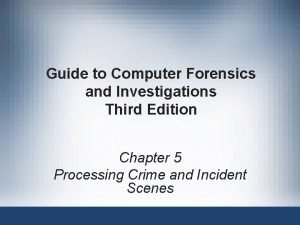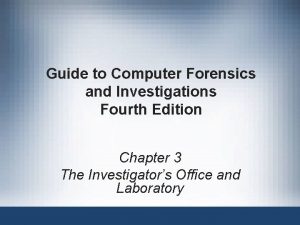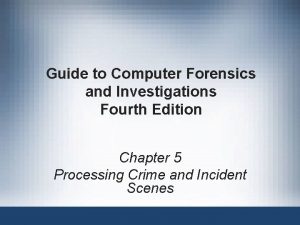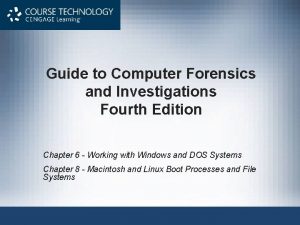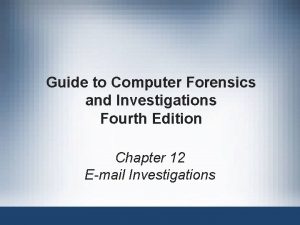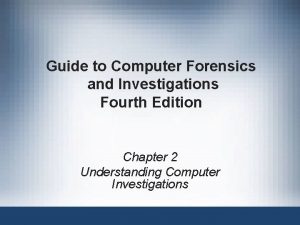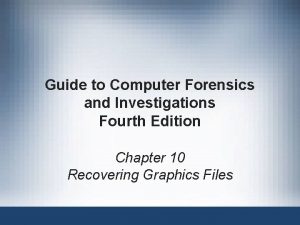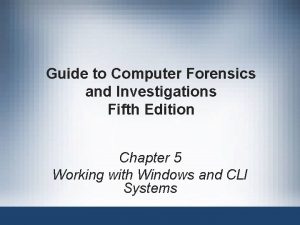Guide to Computer Forensics and Investigations Sixth Edition




























































- Slides: 60

Guide to Computer Forensics and Investigations Sixth Edition Chapter 13 Cloud Forensics

Objectives • Describe the main concepts of cloud computing • Summarize the legal challenges in conducting cloud forensics • Give an overview of the technical challenges with cloud forensics • Describe how to acquire cloud data • Explain how to conduct a cloud investigation • Explain what remote access tools can be used for cloud investigations © 2019 Cengage. May not be copied, scanned, or duplicated, in whole or in part, except for use as permitted in a license distributed with a certain product or service or otherwise on a password-protected website for classroom use. 2

An Overview of Cloud Computing • The cloud has introduced ways of managing data that didn’t exist a decade ago • Cloud investigations have unique challenges • New standards are being developed to improve security practices and incident responses in cloud environments © 2019 Cengage. May not be copied, scanned, or duplicated, in whole or in part, except for use as permitted in a license distributed with a certain product or service or otherwise on a password-protected website for classroom use. 3

History of the Cloud (1 of 2) • Idea of cloud computing came from several people: • Professor John Mc. Carthy of MIT • Dr. J. C. R. Licklider, director at the U. S. Department of Defense Advanced Research Projects Agency (ARPA) • In 1999, Salesforce. com developed a Web service that applied digital marketing research to business subscribers • This service led the way to the cloud © 2019 Cengage. May not be copied, scanned, or duplicated, in whole or in part, except for use as permitted in a license distributed with a certain product or service or otherwise on a password-protected website for classroom use. 4

History of the Cloud (2 of 2) • Amazon created Amazon Mechanical Turk in 2002 • Provided storage, computations, and human intelligence • Started Elastic Compute Cloud (EC 2) in 2006, aimed at supporting small businesses • After Web 2. 0 in 2009, other providers started their own cloud services • Google Apps, Apple i. Cloud, Microsoft One. Drive, and more © 2019 Cengage. May not be copied, scanned, or duplicated, in whole or in part, except for use as permitted in a license distributed with a certain product or service or otherwise on a password-protected website for classroom use. 5

Cloud Service Levels and Deployment Methods (1 of 4) • The National Institute of Standards and Technology (NIST) defines cloud computing as: • A computing storage system that provides on-demand network access for multiple users and can allocate storage to users to keep up with changes in their needs © 2019 Cengage. May not be copied, scanned, or duplicated, in whole or in part, except for use as permitted in a license distributed with a certain product or service or otherwise on a password-protected website for classroom use. 6

Cloud Service Levels and Deployment Methods (2 of 4) • The cloud has three service levels: • Software as a service (Saa. S) - applications are delivered via the Internet • Platform as a service (Paa. S) - an OS has been installed on a cloud server • Infrastructure as a service (Iaa. S) - customers can rent hardware and install whatever OSs and applications they need © 2019 Cengage. May not be copied, scanned, or duplicated, in whole or in part, except for use as permitted in a license distributed with a certain product or service or otherwise on a password-protected website for classroom use. 7

Cloud Service Levels and Deployment Methods (3 of 4) Table 13 -1 Locations of evidence in different service levels Service level Locations of evidence Saa. S Most likely stored on a desktop, laptop, tablet, or smartphone. Paa. S Most likely found on a desktop or server, although it could also be stored on a company network or the remote service provider’s infrastructure. Iaa. S Usually found on a desktop or server; infrastructure equipment can be owned by the company or the remote service provider. © 2019 Cengage. May not be copied, scanned, or duplicated, in whole or in part, except for use as permitted in a license distributed with a certain product or service or otherwise on a password-protected website for classroom use. 8

Cloud Service Levels and Deployment Methods (4 of 4) • Deployment methods for a cloud: • • Public - accessible to anyone Private - can be accessed only by people who have the necessary credentials Community - a way to bring people together for a specific purpose Hybrid - enables a company to keep some information private and designate other files as public or community information © 2019 Cengage. May not be copied, scanned, or duplicated, in whole or in part, except for use as permitted in a license distributed with a certain product or service or otherwise on a password-protected website for classroom use. 9

Cloud Vendors • Some cloud service providers (CSPs) and cloud applications: • • • Salesforce IBM Cloud Cisco Cloud Computing Amazon EC 2 AT&T Synaptic Google Cloud Storage HP Helion Microsoft Azure Xen. Server and Xen. Center Windows Management Console Rackspace Oracle Cloud © 2019 Cengage. May not be copied, scanned, or duplicated, in whole or in part, except for use as permitted in a license distributed with a certain product or service or otherwise on a password-protected website for classroom use. 10

Basic Concepts of Cloud Forensics (1 of 2) • Cloud forensics is considered a subset of network forensics • Cloud forensics can have three dimensions: • Organizational - addresses the structure of the cloud • Legal - covers service agreements and other jurisdictional matters • Technical - deals with procedures and specialized applications designed to perform forensics recovery and analysis in the cloud © 2019 Cengage. May not be copied, scanned, or duplicated, in whole or in part, except for use as permitted in a license distributed with a certain product or service or otherwise on a password-protected website for classroom use. 11

Basic Concepts of Cloud Forensics (2 of 2) • Forensic tool capabilities needed to handle acquiring data from a cloud: • Forensic data collection - must be able to identify, label, record, and acquire data from the cloud • Elastic, static, and live forensics - must be able to expand contract their storage capabilities • Evidence segregation - different businesses and users share the same applications and storage space • Investigations in virtualized environments - should have the capability to examine virtual systems © 2019 Cengage. May not be copied, scanned, or duplicated, in whole or in part, except for use as permitted in a license distributed with a certain product or service or otherwise on a password-protected website for classroom use. 12

Legal Challenges in Cloud Forensics • When investigating a cloud system, consider factors involving a CSP’s relationship with cloud users • This section explains: • A CSP’s contract obligations with cloud users • How warrants and subpoenas are applied to CSPs and users © 2019 Cengage. May not be copied, scanned, or duplicated, in whole or in part, except for use as permitted in a license distributed with a certain product or service or otherwise on a password-protected website for classroom use. 13

Service Level Agreements (1 of 5) • Cloud service agreements (CSAs) - a contract between a CSP and the customer that describes what services are being provided and at what level • Includes service legal agreements (SLAs) • CSAs should also specify: • • • Support options Penalties for services not provided System performance Fees Provided software or hardware © 2019 Cengage. May not be copied, scanned, or duplicated, in whole or in part, except for use as permitted in a license distributed with a certain product or service or otherwise on a password-protected website for classroom use. 14

Service Level Agreements (2 of 5) • CSAs define the scope of services the CSP provides: • • Service hours Restrictions applied to the customer by the CSP Availability of the cloud to the customer Levels of support for the customer Response time for data transfers Throughput, limitations Contingency plan for incident response Business continuity and disaster recovery plan © 2019 Cengage. May not be copied, scanned, or duplicated, in whole or in part, except for use as permitted in a license distributed with a certain product or service or otherwise on a password-protected website for classroom use. 15

Service Level Agreements (3 of 5) • CSAs define the scope of services the CSP provides (cont’d): • Fees for the subscription to the cloud and fees for additional services as they occur • Security measures • Terminology of the cloud’s systems and applications • CSP components must state who is authorized to access data and what the limitations are in conducting acquisitions for an investigation © 2019 Cengage. May not be copied, scanned, or duplicated, in whole or in part, except for use as permitted in a license distributed with a certain product or service or otherwise on a password-protected website for classroom use. 16

Service Level Agreements (4 of 5) • Policies, Standards, and Guidelines for CSPs • Digital forensics should review CSPs policies, standards, and guidelines for daily operations • Policies - detailed rules for a CSP’s internal operation • Standards - give guidance to staff for unique operations, hardware, and software and describe the staff’s obligations regarding security of the CSP environment • Guidelines - describe best practices for cloud processes and give staff an example of what they should strive to achieve in their work © 2019 Cengage. May not be copied, scanned, or duplicated, in whole or in part, except for use as permitted in a license distributed with a certain product or service or otherwise on a password-protected website for classroom use. 17

Service Level Agreements (5 of 5) • CSP Processes and Procedures - are detailed documents that define workflow and step-by-step instructions for CSP staff • Often include hardware configuration diagrams, network maps, and application processing flowcharts • Digital forensics examiners can use them to understand how data is stored, manipulated, secured, backed up, restored, and accessed by CSP staff and customers • Additional documents of interest: • CSP business continuity and disaster recovery plans © 2019 Cengage. May not be copied, scanned, or duplicated, in whole or in part, except for use as permitted in a license distributed with a certain product or service or otherwise on a password-protected website for classroom use. 18

Jurisdiction Issues (1 of 2) • Although there are plans to revise current laws • Many cross-jurisdiction legal issues haven’t been resolved • No law ensures uniform access or required handling procedures for the cloud • Investigators should be concerned about cases involving data commingled with other customers’ data • Often, figuring out what law controls data stored in the cloud is a challenge © 2019 Cengage. May not be copied, scanned, or duplicated, in whole or in part, except for use as permitted in a license distributed with a certain product or service or otherwise on a password-protected website for classroom use. 19

Jurisdiction Issues (2 of 2) • How privacy rights are defined in different jurisdictions is a major factor in problems with the right to access data • EU Directive 95/46/EC is more restrictive than rules in other countries, including the U. S. • Protects private information for all EU citizens • Digital forensics examiners could be held liable when conducting an investigation involving cloud data • Consult with legal experts to be aware of possible restrictions © 2019 Cengage. May not be copied, scanned, or duplicated, in whole or in part, except for use as permitted in a license distributed with a certain product or service or otherwise on a password-protected website for classroom use. 20

Accessing Evidence in the Cloud (1 of 4) • The Electronic Communications Privacy Act (ECPA) describes five mechanisms the government can use to get electronic information from a provider: • • • Search warrants Subpoenas with prior notice to the subscriber or customer Court orders with prior notice to the subscriber or customer © 2019 Cengage. May not be copied, scanned, or duplicated, in whole or in part, except for use as permitted in a license distributed with a certain product or service or otherwise on a password-protected website for classroom use. 21

Accessing Evidence in the Cloud (2 of 4) • Search Warrants • Can be used only in criminal cases and must be requested by a law enforcement officer who has evidence of probable cause that a crime was committed • Law requires search warrants to contain specific descriptions of what’s to be seized • For cloud environments, the property to be seized usually describes data rather than physical hardware, unless the CSP is the suspect © 2019 Cengage. May not be copied, scanned, or duplicated, in whole or in part, except for use as permitted in a license distributed with a certain product or service or otherwise on a password-protected website for classroom use. 22

Accessing Evidence in the Cloud (3 of 4) • Search Warrants (cont’d) • Must also describe the location of items to be seized - Difficult when dealing with cloud data because servers are often dispersed across state or national borders • Must establish how it will be carried out - Specifying the date and time of day to minimize disruptions to people and business operations © 2019 Cengage. May not be copied, scanned, or duplicated, in whole or in part, except for use as permitted in a license distributed with a certain product or service or otherwise on a password-protected website for classroom use. 23

Accessing Evidence in the Cloud (4 of 4) • Subpoenas and Court Orders • Government agency subpoenas - customer communications and records can’t be knowingly divulged to any person or entity - Used to get information when it’s believed there’s a danger of death or serious physical injury • Non-government and civil litigation subpoenas - used to produce information from private parties for litigation • Court orders - written by judges to compel someone to do or not do something © 2019 Cengage. May not be copied, scanned, or duplicated, in whole or in part, except for use as permitted in a license distributed with a certain product or service or otherwise on a password-protected website for classroom use. 24

Technical Challenges in Cloud Forensics • Challenges in conducting cloud forensics • • Architecture Data collection Analysis of cloud forensic data Anti-forensics Incident first responders Role management Legal issues Standards and training © 2019 Cengage. May not be copied, scanned, or duplicated, in whole or in part, except for use as permitted in a license distributed with a certain product or service or otherwise on a password-protected website for classroom use. 25

Architecture • No two CSPs are configured exactly the same way • Depending on the type of cloud architecture • Customer’s data could be commingled • Most CSPs keep data storage locations secret for security reasons • Differences in recording procedures or log keeping can make it difficult to determine data’s origin • And complicate an investigation’s chain of evidence © 2019 Cengage. May not be copied, scanned, or duplicated, in whole or in part, except for use as permitted in a license distributed with a certain product or service or otherwise on a password-protected website for classroom use. 26

Analysis of Cloud Forensic Data • Analyzing digital evidence from a cloud requires verifying the data with other data and log records • Data may need to be reconstructed to determine what actually occurred during an incident • Examining logs can be useful to compare the modified, last access, and create (MAC) dates and times for files © 2019 Cengage. May not be copied, scanned, or duplicated, in whole or in part, except for use as permitted in a license distributed with a certain product or service or otherwise on a password-protected website for classroom use. 27

Anti-Forensics (1 of 2) • Anti-forensics - destroying ESI that may be potential evidence • Hackers may use specialized malware for defeating evidence collection • Additional methods for anti-forensics: • Inserting malware programs in other files • Using encryption to obfuscate malware programs activated through other malware programs • Using data-hiding utilities that append malware to existing files © 2019 Cengage. May not be copied, scanned, or duplicated, in whole or in part, except for use as permitted in a license distributed with a certain product or service or otherwise on a password-protected website for classroom use. 28

Anti-Forensics (2 of 2) • Other techniques affect file metadata by changing the modify and last access times • Changing timestamps can make it difficult to develop a timeline of a hacker’s activities • Calculating hash values of files and comparing the results with known good files’ hash values can help identify files that might have been altered © 2019 Cengage. May not be copied, scanned, or duplicated, in whole or in part, except for use as permitted in a license distributed with a certain product or service or otherwise on a password-protected website for classroom use. 29

Incident First Responders (1 of 2) • CSPs have personnel trained to respond to network incidents • They become first responders when a network intrusion occurs • When CSPs do not have an internal first responder team, the forensics examiner should organize CSP staff to handle these tasks © 2019 Cengage. May not be copied, scanned, or duplicated, in whole or in part, except for use as permitted in a license distributed with a certain product or service or otherwise on a password-protected website for classroom use. 30

Incident First Responders (2 of 2) • Some factors to address include: • Will the CSP’s operations staff be cooperative and follow directions, and will management issue orders stating that you’re the leader of the investigation? • Do you need to brief staff about operations security? For example, you might need to explain that they should talk only to others who have a need to know about the incident and the investigation’s activities • Do you need to train staff in evidence collection procedures, including the chain of custody? © 2019 Cengage. May not be copied, scanned, or duplicated, in whole or in part, except for use as permitted in a license distributed with a certain product or service or otherwise on a password-protected website for classroom use. 31

Role Management • Role management in the cloud covers: • • Data owners Identity protection Users Access controls • As an investigator, you need to collect this information so you can identify additional victims or suspects © 2019 Cengage. May not be copied, scanned, or duplicated, in whole or in part, except for use as permitted in a license distributed with a certain product or service or otherwise on a password-protected website for classroom use. 32

Standards and Training (1 of 2) • There is an effort to standardize cloud architectures for: • • Operating procedures Interoperability Testing Validation • The Cloud Security Alliance (CSA) has develop resource documentation for CSPs and their staff © 2019 Cengage. May not be copied, scanned, or duplicated, in whole or in part, except for use as permitted in a license distributed with a certain product or service or otherwise on a password-protected website for classroom use. 33

Standards and Training (2 of 2) • Cloud investigators should have an understanding of cloud architecture • In addition to basic digital and network forensic skills • Sources for cloud forensics training: • • • (ISC)²’s Certified Cyber Forensics Professional INFOSEC Institute SANS Cloud Forensics with F-Response National Institute of Justice Digital Forensics Training University College Dublin Centre for Cybersecurity and Cybercrime Investigation © 2019 Cengage. May not be copied, scanned, or duplicated, in whole or in part, except for use as permitted in a license distributed with a certain product or service or otherwise on a password-protected website for classroom use. 34

Acquisitions in the Cloud • Methods used to collect evidence in cloud investigations depend on the nature of the case • Recovering deleted data from cloud storage might be limited to the type of file system the CSP uses • With cloud systems running in a virtual environment, snapshots can give you valuable information before, during, and after an incident • Forensic examiners should re-create separate cloud servers from each snapshot, acquire an image of each server, and calculate a hash for all files © 2019 Cengage. May not be copied, scanned, or duplicated, in whole or in part, except for use as permitted in a license distributed with a certain product or service or otherwise on a password-protected website for classroom use. 35

Encryption in the Cloud (1 of 3) • Many CSPs and third parties offer encryption services for cloud users as a security measure • Expect to find encrypted files in cloud investigations • You need assistance from the data owner or the CSP to decrypt data with the right encryption key • If data owner is uncooperative, you may need to turn to the attorneys handling the case or data owner’s management © 2019 Cengage. May not be copied, scanned, or duplicated, in whole or in part, except for use as permitted in a license distributed with a certain product or service or otherwise on a password-protected website for classroom use. 36

Encryption in the Cloud (2 of 3) • Encrypted data in the cloud is in two states: • Data at rest - data that has been written to disk • Data in motion - data being transmitted over a network • Some system also have encryption for data in use (data that’s in RAM) • If encrypted data is encountered • Find out from the CSP what type of encryption was used and who knows how to recover it © 2019 Cengage. May not be copied, scanned, or duplicated, in whole or in part, except for use as permitted in a license distributed with a certain product or service or otherwise on a password-protected website for classroom use. 37

Encryption in the Cloud (3 of 3) • Vendors that offer encryption services for cloud data: • Atalla Cloud Encryption from Micro Focus • Secure. Cloud from Trend Micro • Safe. Guard Encryption and Sophos Mobile Control from Sophos • Homomorphic encryption • Uses an “ideal lattice” mathematical formula to encrypt data • Block chain technology • Used by companies such as Bitcoin, is a way to trace your information while keeping it secure © 2019 Cengage. May not be copied, scanned, or duplicated, in whole or in part, except for use as permitted in a license distributed with a certain product or service or otherwise on a password-protected website for classroom use. 38

Conducting a Cloud Investigation • When investigating cloud incidents: • Use a systematic approach just like the one covered in Chapter 1 • The type of incident determines how to proceed with planning the investigation • If the investigation involves searching for and recovering data from cloud storage or cloud customers • Follow methods described in Chapters 5 and 6 © 2019 Cengage. May not be copied, scanned, or duplicated, in whole or in part, except for use as permitted in a license distributed with a certain product or service or otherwise on a password-protected website for classroom use. 39

Investigating CSPs (1 of 2) • If a CSP has no team or limited staff, investigators should ask the following questions to understand how the CSP is set up: • Does the investigator have the authority to use cloud staff and resources to conduct an investigation? • Is detailed knowledge of the cloud’s topology, policies, data storage methods, and devices available? • Are there any restrictions on collecting digital evidence from remote cloud storage? © 2019 Cengage. May not be copied, scanned, or duplicated, in whole or in part, except for use as permitted in a license distributed with a certain product or service or otherwise on a password-protected website for classroom use. 40

Investigating CSPs (2 of 2) • Investigators should ask the following questions to understand how the CSP is set up (cont’d): • For e-discovery demands on multitenant cloud systems, is the data to collect commingled with other cloud customers’ unrelated data? Is there a way to separate the data to prevent violating privacy rights or confidentiality agreements? • Is the data of interest to the investigation local or remote? If it’s in a remote location, can the CSP provide a forensically sound connection to it? © 2019 Cengage. May not be copied, scanned, or duplicated, in whole or in part, except for use as permitted in a license distributed with a certain product or service or otherwise on a password-protected website for classroom use. 41

Investigating Cloud Customers • If a cloud customer doesn’t have the CSP’s application installed • You might find cloud-related evidence in a Web browser’s cache file • If the CSP’s application is installed • You can find evidence of file transfers in the application’s folder • Usually found under the user’s account folder © 2019 Cengage. May not be copied, scanned, or duplicated, in whole or in part, except for use as permitted in a license distributed with a certain product or service or otherwise on a password-protected website for classroom use. 42

Understanding Prefetch Files (1 of 2) • Prefetch files - contain the DLL pathnames and metadata used by an application • The OS reads the associated prefetch file and loads its information into the computer’s memory • Speeds an application’s start time • The OS can handle other tasks instead of waiting for an application to load needed libraries • Example: • Metadata in a prefetch files contains an application’s MAC times in UTC format and a counter of how many times the app has run © 2019 Cengage. May not be copied, scanned, or duplicated, in whole or in part, except for use as permitted in a license distributed with a certain product or service or otherwise on a password-protected website for classroom use. 43

Understanding Prefetch Files (2 of 2) © 2019 Cengage. May not be copied, scanned, or duplicated, in whole or in part, except for use as permitted in a license distributed with a certain product or service or otherwise on a password-protected website for classroom use. 44

Examining Stored Cloud Data on a PC (1 of 6) • Three widely used cloud services: • Dropbox • Google Drive • One. Drive • Services are free for storage up to 2 GB for Dropbox and up to 15 GB for Google Drive and One. Drive • These applications have Registry entries • Users must maintain control over access to their cloud accounts © 2019 Cengage. May not be copied, scanned, or duplicated, in whole or in part, except for use as permitted in a license distributed with a certain product or service or otherwise on a password-protected website for classroom use. 45

Examining Stored Cloud Data on a PC (2 of 6) • Dropbox offers third-party applications, such as e-mail, chat, Cisco Web. Ex, and other collaboration tools • Since 2012, Dropbox has used base-64 format to store content • Reading them requires specialized software • Magnet Forensics has a tool called Internet Evidence Finder (IEF) designed for this purpose © 2019 Cengage. May not be copied, scanned, or duplicated, in whole or in part, except for use as permitted in a license distributed with a certain product or service or otherwise on a password-protected website for classroom use. 46

Examining Stored Cloud Data on a PC (3 of 6) • Gmail users have access to Google Drive for cloud data storage and applications • Google Drive is installed in: • C: Program Files (x 86)GoogleDrive • Each user has a configuration file stored in C: UsersusernameApp. DataLocalGoogleDrive • Called a “user profile” • If Google Drive has been installed, it creates a folder in the path C: UsersusernameGoogle Drive © 2019 Cengage. May not be copied, scanned, or duplicated, in whole or in part, except for use as permitted in a license distributed with a certain product or service or otherwise on a password-protected website for classroom use. 47

Examining Stored Cloud Data on a PC (4 of 6) • Important Google Drive files: • sync_config. db - an SQL database file with Google Drive upgrade number, highest application version number, and local synchronization root path • snapshot. db - contains information about each file accessed, the URL pathname, the modified and created dates and times in UNIX timestamp format, and the file’s MD 5 value and size • sync_log. log - has a detailed list of a user’s cloud transactions © 2019 Cengage. May not be copied, scanned, or duplicated, in whole or in part, except for use as permitted in a license distributed with a certain product or service or otherwise on a password-protected website for classroom use. 48

Examining Stored Cloud Data on a PC (5 of 6) • One. Drive - created by Microsoft and was originally called Sky. Drive • Available with Windows 8 and later • Similar to Drop. Box and Google Drive and offers subscription services for Microsoftware • One. Drive stores user profiles in the user’s account path • Log files and synchronized files are kept in various places under the user’s account (depending on the Windows version) © 2019 Cengage. May not be copied, scanned, or duplicated, in whole or in part, except for use as permitted in a license distributed with a certain product or service or otherwise on a password-protected website for classroom use. 49

Examining Stored Cloud Data on a PC (6 of 6) • You can find more information in the following Windows 8. 1 log files, which are in the C: UsersusernameApp. DataLocalMicrosoftWindowsSky. Drivelogs folder • Sync. Engine-yyyy-mm-ddnn. nnn-n. et 1 manages synchronization between One. Drive and a user’s computer • Sync. Diagnostics. log contains client ID, client. Type, client. Version, device. ID, and time. Utc values © 2019 Cengage. May not be copied, scanned, or duplicated, in whole or in part, except for use as permitted in a license distributed with a certain product or service or otherwise on a password-protected website for classroom use. 50

Windows Prefetch Artifacts • You can collect prefetch file artifacts with a disk editor or forensics tool • Follow the steps in the activity starting on page 546 to use Win. Hex’s Data Interpreter to find an application’s MAC dates and times • And the number of times Drop. Box has run © 2019 Cengage. May not be copied, scanned, or duplicated, in whole or in part, except for use as permitted in a license distributed with a certain product or service or otherwise on a password-protected website for classroom use. 51

Tools for Cloud Forensics • Few tools designed for cloud forensics were available • Many digital, network, and e-discovery tools can be combined to collect and analyze cloud data • Some vendor with integrated tools: • Guidance Software En. Case e. Discovery • Access. Data Digital Forensics Incident Response • F-Response © 2019 Cengage. May not be copied, scanned, or duplicated, in whole or in part, except for use as permitted in a license distributed with a certain product or service or otherwise on a password-protected website for classroom use. 52

Forensic Open-Stack Tools (1 of 2) • Forensic Open-Stack Tools (FROST) integrates with Open. Stack running in Iaa. S cloud environments • Adds forensics response capabilities for a CSP • Open. Stack - an open-source computing platform intended for public and private cloud services • FROST is the first known effort to provide a forensics response process for a cloud service © 2019 Cengage. May not be copied, scanned, or duplicated, in whole or in part, except for use as permitted in a license distributed with a certain product or service or otherwise on a password-protected website for classroom use. 53

Forensic Open-Stack Tools (2 of 2) • A feature of FROST • It bypasses a VMs hypervisor • Collected data is placed in the cloud’s management plane, which is a tool with application programming interfaces that allow reconfiguring the cloud on the fly • Special malware can take control of the virtual session and deny or alter access • Can also prevent or interfere with forensic analysis and data collection © 2019 Cengage. May not be copied, scanned, or duplicated, in whole or in part, except for use as permitted in a license distributed with a certain product or service or otherwise on a password-protected website for classroom use. 54

F-Response for the Cloud • F-Response is a remote access tool that can be applied to cloud forensics • Uses USB forwarding techniques to allow non-remote-capable forensics tools to access remote servers and their data storage • Two tools are needed: • F-Response Enterprise or Consultant • Kernel. Pro USB-Over-Ethernet © 2019 Cengage. May not be copied, scanned, or duplicated, in whole or in part, except for use as permitted in a license distributed with a certain product or service or otherwise on a password-protected website for classroom use. 55

Magnet AXIOM Cloud • Magnet AXIOM created a Cloud module to go with its Process and Examine modules • Magnet AXIOM Cloud • Retrieves information from Facebook Messenger, Skype, Instagram, Twitter, i. Cloud, and others • You still need usernames and passwords © 2019 Cengage. May not be copied, scanned, or duplicated, in whole or in part, except for use as permitted in a license distributed with a certain product or service or otherwise on a password-protected website for classroom use. 56

Summary (1 of 4) • Three service levels are available for the cloud: software as a service, platform as a service, and infrastructure as a service • CSPs use servers on distributive networks or mainframes that allow elasticity of resources for customers • With multinational clouds, you should seek legal counsel before proceeding with an investigation • Cloud investigations are necessary in cases involving cyberattacks, policy violations, data recovery, and fraud complaints © 2019 Cengage. May not be copied, scanned, or duplicated, in whole or in part, except for use as permitted in a license distributed with a certain product or service or otherwise on a password-protected website for classroom use. 57

Summary (2 of 4) • Before initiating a cloud investigations, review the CSA to identify any restrictions that might limit collecting and analyzing data • Technical challenges in cloud forensics involve cloud architecture, data collection, analysis of cloud forensic data, anti-forensics, incident first responders, role management, legal issues, and standards and training • Anti-forensics is an effort to alter log records as well as date and time values of important system files and install malware to hide hacker’s activities © 2019 Cengage. May not be copied, scanned, or duplicated, in whole or in part, except for use as permitted in a license distributed with a certain product or service or otherwise on a password-protected website for classroom use. 58

Summary (3 of 4) • CSPs should have an incident response team ready to respond to network intrusions • Role management defines the duties of CSP staff and customers • The Cloud Security Alliance has developed resources that guide CSPs in privacy agreements and security measures • Procedures for acquiring cloud evidence include examining network and firewall logs, performing disk acquisitions of a cloud system’s OS, and examining data storage devices © 2019 Cengage. May not be copied, scanned, or duplicated, in whole or in part, except for use as permitted in a license distributed with a certain product or service or otherwise on a password-protected website for classroom use. 59

Summary (4 of 4) • When investigating a cloud incident, apply a systematic approach to planning and processing the case • The three cloud services Dropbox, Google Drive, and Microsoft One. Drive contain data on a user’s computer or mobile device that can reveal what files were copied or accessed • Vendors offer tools that can be combined for cloud forensics © 2019 Cengage. May not be copied, scanned, or duplicated, in whole or in part, except for use as permitted in a license distributed with a certain product or service or otherwise on a password-protected website for classroom use. 60
 Marking bad clusters data hiding technique
Marking bad clusters data hiding technique Guide to computer forensics and investigations 5th edition
Guide to computer forensics and investigations 5th edition Guide to computer forensics and investigations
Guide to computer forensics and investigations Computer architecture a quantitative approach sixth edition
Computer architecture a quantitative approach sixth edition Computer architecture a quantitative approach 6th
Computer architecture a quantitative approach 6th Computer architecture a quantitative approach sixth edition
Computer architecture a quantitative approach sixth edition Peter piper tongue twister
Peter piper tongue twister The sixth sick sheik's sixth sheep's sick lyrics
The sixth sick sheik's sixth sheep's sick lyrics Biochemistry sixth edition 2007 w.h. freeman and company
Biochemistry sixth edition 2007 w.h. freeman and company Automotive technology principles diagnosis and service
Automotive technology principles diagnosis and service Automotive technology sixth edition
Automotive technology sixth edition Apa sixth edition
Apa sixth edition Precalculus sixth edition
Precalculus sixth edition Rational people think at the margin
Rational people think at the margin Forensic science fundamentals and investigations chapter 6
Forensic science fundamentals and investigations chapter 6 Computer forensics report template
Computer forensics report template Digital forensics denver
Digital forensics denver Computer forensics workstation
Computer forensics workstation Objectives of computer forensics
Objectives of computer forensics Introduction to computer forensics
Introduction to computer forensics Computer forensics tool testing
Computer forensics tool testing Tasks performed by computer forensics tools
Tasks performed by computer forensics tools What is computer forensics
What is computer forensics Advanced computer forensics
Advanced computer forensics Fastbloc
Fastbloc Mis chapter 6
Mis chapter 6 Mis
Mis Why aren t descriptive investigations repeatable
Why aren t descriptive investigations repeatable Year 6 maths investigations
Year 6 maths investigations Craigslist private investigator
Craigslist private investigator Unit 3 statistical studies answers
Unit 3 statistical studies answers Statistical investigations examples
Statistical investigations examples Toledo bmv heatherdowns
Toledo bmv heatherdowns Conclusion for scientific method
Conclusion for scientific method Pasco county child protective services
Pasco county child protective services Chs investigations
Chs investigations Iliac region
Iliac region Verifact investigations
Verifact investigations 3 weeks pregnant ultrasound
3 weeks pregnant ultrasound Investigations
Investigations Chs investigations
Chs investigations Florida real estate broker's guide 6th edition
Florida real estate broker's guide 6th edition Florida real estate broker's guide
Florida real estate broker's guide Pocket guide to public speaking
Pocket guide to public speaking Guide to wireless communications
Guide to wireless communications Prehospital emergency care 11th edition
Prehospital emergency care 11th edition The no brokerage relationship notice must be disclosed
The no brokerage relationship notice must be disclosed Florida real estate broker's guide 6th edition
Florida real estate broker's guide 6th edition Cwna guide to wireless lans 3rd edition
Cwna guide to wireless lans 3rd edition Florida real estate broker's guide 6th edition
Florida real estate broker's guide 6th edition A pocket guide to public speaking 6th edition
A pocket guide to public speaking 6th edition A pocket guide to public speaking 6th edition
A pocket guide to public speaking 6th edition Dk guide to public speaking 2nd edition
Dk guide to public speaking 2nd edition Florida real estate broker's guide 6th edition
Florida real estate broker's guide 6th edition Florida real estate broker's guide
Florida real estate broker's guide Florida real estate broker's guide
Florida real estate broker's guide Digital design and computer architecture
Digital design and computer architecture Data and computer communications 10th edition
Data and computer communications 10th edition Computer security principles and practice
Computer security principles and practice Computer organization and architecture 10th edition
Computer organization and architecture 10th edition Computer security principles and practice 4th edition
Computer security principles and practice 4th edition

